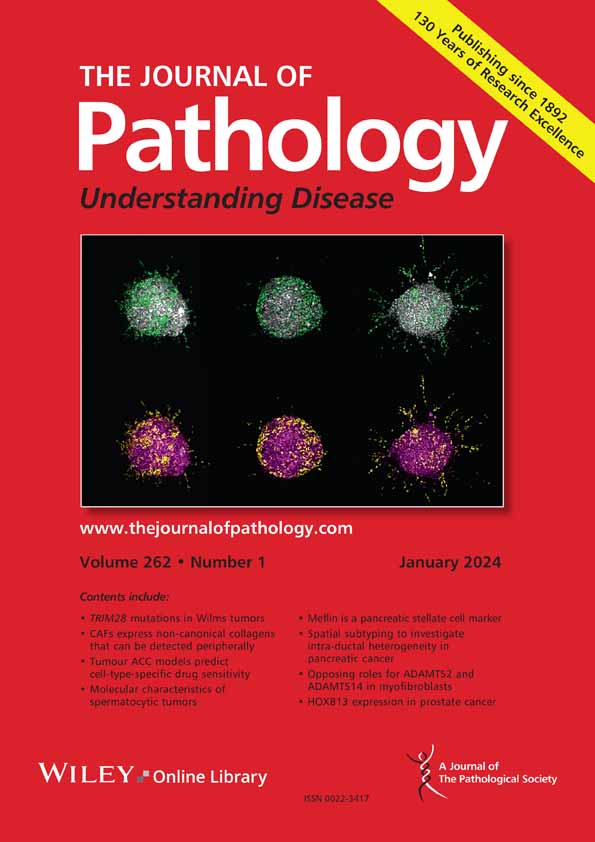Development and characterisation of improved unifocal primary mouse lung cancer models with metastatic potential
IF 5.2
2区 医学
Q1 ONCOLOGY
Ana-Rita Pedrosa, Alejandro Castillo-Kauil, Yuliia Kravchuk, Louise Reynolds, Bruce Williams, David Moore, Cameron Lang, Srinivas Allanki, Eleni Maniati, Alexandros Hardas, Jozafina Haj, Rebecca Drake, Julie Cleaver, Julie Foster, Jana Kim, Ester Stern, Jane Sosabowski, Gilbert O. Fruhwirth, Erik Sahai, Ori Wald, Kairbaan Hodivala-Dilke
下载PDF
{"title":"Development and characterisation of improved unifocal primary mouse lung cancer models with metastatic potential","authors":"Ana-Rita Pedrosa, Alejandro Castillo-Kauil, Yuliia Kravchuk, Louise Reynolds, Bruce Williams, David Moore, Cameron Lang, Srinivas Allanki, Eleni Maniati, Alexandros Hardas, Jozafina Haj, Rebecca Drake, Julie Cleaver, Julie Foster, Jana Kim, Ester Stern, Jane Sosabowski, Gilbert O. Fruhwirth, Erik Sahai, Ori Wald, Kairbaan Hodivala-Dilke","doi":"10.1002/path.6435","DOIUrl":null,"url":null,"abstract":"<p>Lung cancer is the leading cause of cancer-related death globally. To better understand the biology of lung cancer, mouse models have been developed using either tail vein-injected tumour cell lines or genetically modified mice. The current gold-standard models typically present with multiple lung foci. However, although these models are widely used, their correlation with human disease are limited, as early-stage human lung cancer usually presents as a single lesion rather than multiple foci. Additionally, a major challenge of using multifocal lung tumour models is the difficulty in distinguishing primary lung tumours from intrathoracic metastasis and lethal levels of lung congestion before distant metastases develop. Here, we present a refined and detailed surgical method in which murine tumour cells [Lewis lung carcinoma (LLC), alveogenic lung carcinoma (CMT), or <i>Kras/Trp53-</i>KP mutant cells] were injected directly into the left lung lobe of C57BL/6 mice, or, alternatively, adenoviral-Cre or adenoviral-FlpO was administered directly into the left lung lobe of <i>Kras</i><sup><i>LSL-G12D</i></sup>;<i>Trp53</i><sup><i>fl/fl</i></sup> or <i>Kras</i><sup><i>FSF-G12D</i></sup>;<i>Trp53</i><sup><i>frt/frt</i></sup> (KP) mice, respectively. This method generated unifocal primary left lung lobe tumours with traceable spread to local and distant sites. A cross-comparison of the unifocal models described commonalties and differences between LLC, CMT, KP cells, and adenoviral-Cre or -FlpO methods in terms of timings for primary lung tumour growth and traceable spread to local and distant sites, histological analysis of CD3 and CD11b immune cell infiltration, and Picrosirius Red analysis of extracellular matrix complexity. Lastly, the frequency of clinical histopathological features typical of human lung cancer were assessed across the unifocal mouse models to provide a direct comparison with human lung cancer. Overall, this study details a refined and reproducible protocol for intralobular lung injection to generate unifocal lung cancer models that resemble key features of human lung cancer. This approach can be applied to other lung cancer initiation strategies. The cross-comparative histological analysis across the models tested here offers a valuable resource to aid researchers in selecting the most appropriate next-generation unifocal lung cancer models for their specific research needs. © 2025 The Author(s). <i>The Journal of Pathology</i> published by John Wiley & Sons Ltd on behalf of The Pathological Society of Great Britain and Ireland.</p>","PeriodicalId":232,"journal":{"name":"The Journal of Pathology","volume":"266 4-5","pages":"405-420"},"PeriodicalIF":5.2000,"publicationDate":"2025-06-18","publicationTypes":"Journal Article","fieldsOfStudy":null,"isOpenAccess":false,"openAccessPdf":"https://onlinelibrary.wiley.com/doi/epdf/10.1002/path.6435","citationCount":"0","resultStr":null,"platform":"Semanticscholar","paperid":null,"PeriodicalName":"The Journal of Pathology","FirstCategoryId":"3","ListUrlMain":"https://pathsocjournals.onlinelibrary.wiley.com/doi/10.1002/path.6435","RegionNum":2,"RegionCategory":"医学","ArticlePicture":[],"TitleCN":null,"AbstractTextCN":null,"PMCID":null,"EPubDate":"","PubModel":"","JCR":"Q1","JCRName":"ONCOLOGY","Score":null,"Total":0}
引用次数: 0
引用
批量引用
Abstract
Lung cancer is the leading cause of cancer-related death globally. To better understand the biology of lung cancer, mouse models have been developed using either tail vein-injected tumour cell lines or genetically modified mice. The current gold-standard models typically present with multiple lung foci. However, although these models are widely used, their correlation with human disease are limited, as early-stage human lung cancer usually presents as a single lesion rather than multiple foci. Additionally, a major challenge of using multifocal lung tumour models is the difficulty in distinguishing primary lung tumours from intrathoracic metastasis and lethal levels of lung congestion before distant metastases develop. Here, we present a refined and detailed surgical method in which murine tumour cells [Lewis lung carcinoma (LLC), alveogenic lung carcinoma (CMT), or Kras/Trp53- KP mutant cells] were injected directly into the left lung lobe of C57BL/6 mice, or, alternatively, adenoviral-Cre or adenoviral-FlpO was administered directly into the left lung lobe of Kras LSL-G12D Trp53 fl/fl Kras FSF-G12D Trp53 frt/frt The Journal of Pathology published by John Wiley & Sons Ltd on behalf of The Pathological Society of Great Britain and Ireland.
具有转移潜力的改进的单灶原发性小鼠肺癌模型的发展和特征。
肺癌是全球癌症相关死亡的主要原因。为了更好地了解肺癌的生物学特性,研究人员利用静脉注射肿瘤细胞系或转基因小鼠建立了小鼠模型。目前的金标准模型通常表现为多发肺灶。然而,尽管这些模型被广泛使用,但它们与人类疾病的相关性有限,因为早期人类肺癌通常表现为单个病变,而不是多个病灶。此外,使用多灶性肺肿瘤模型的一个主要挑战是难以区分原发性肺肿瘤与胸内转移瘤和远处转移发生前肺充血的致死水平。在这里,我们提出了一种精细而详细的手术方法,将小鼠肿瘤细胞[Lewis肺癌(LLC)、肺泡性肺癌(CMT)或Kras/Trp53-KP突变细胞]直接注射到C57BL/6小鼠的左肺中,或者将腺病毒- cre或腺病毒- flpo分别直接注射到KrasLSL-G12D、Trp53fl/fl或KrasFSF-G12D、Trp53frt/frt (KP)小鼠的左肺中。这种方法产生单灶性原发性左肺叶肿瘤,可追溯扩散到局部和远处。单一模型的交叉比较描述了LLC, CMT, KP细胞和腺病毒- cre或-FlpO方法在原发性肺肿瘤生长时间和可追溯的局部和远处扩散,CD3和CD11b免疫细胞浸润的组织学分析以及Picrosirius Red细胞外基质复杂性分析方面的共同点和差异。最后,通过单灶小鼠模型评估人类肺癌典型临床组织病理学特征的频率,以提供与人类肺癌的直接比较。总体而言,本研究详细介绍了一种精细且可重复的小叶内肺注射方案,以生成与人类肺癌关键特征相似的单灶肺癌模型。该方法可应用于其他肺癌起始策略。交叉比较组织学分析在这里测试的模型提供了一个宝贵的资源,以帮助研究人员选择最合适的下一代单灶性肺癌模型,以满足他们的具体研究需求。©2025作者。《病理学杂志》由John Wiley & Sons Ltd代表大不列颠和爱尔兰病理学会出版。
本文章由计算机程序翻译,如有差异,请以英文原文为准。
来源期刊
期刊介绍:
The Journal of Pathology aims to serve as a translational bridge between basic biomedical science and clinical medicine with particular emphasis on, but not restricted to, tissue based studies. The main interests of the Journal lie in publishing studies that further our understanding the pathophysiological and pathogenetic mechanisms of human disease.
The Journal of Pathology welcomes investigative studies on human tissues, in vitro and in vivo experimental studies, and investigations based on animal models with a clear relevance to human disease, including transgenic systems.
As well as original research papers, the Journal seeks to provide rapid publication in a variety of other formats, including editorials, review articles, commentaries and perspectives and other features, both contributed and solicited.




 求助内容:
求助内容: 应助结果提醒方式:
应助结果提醒方式:


